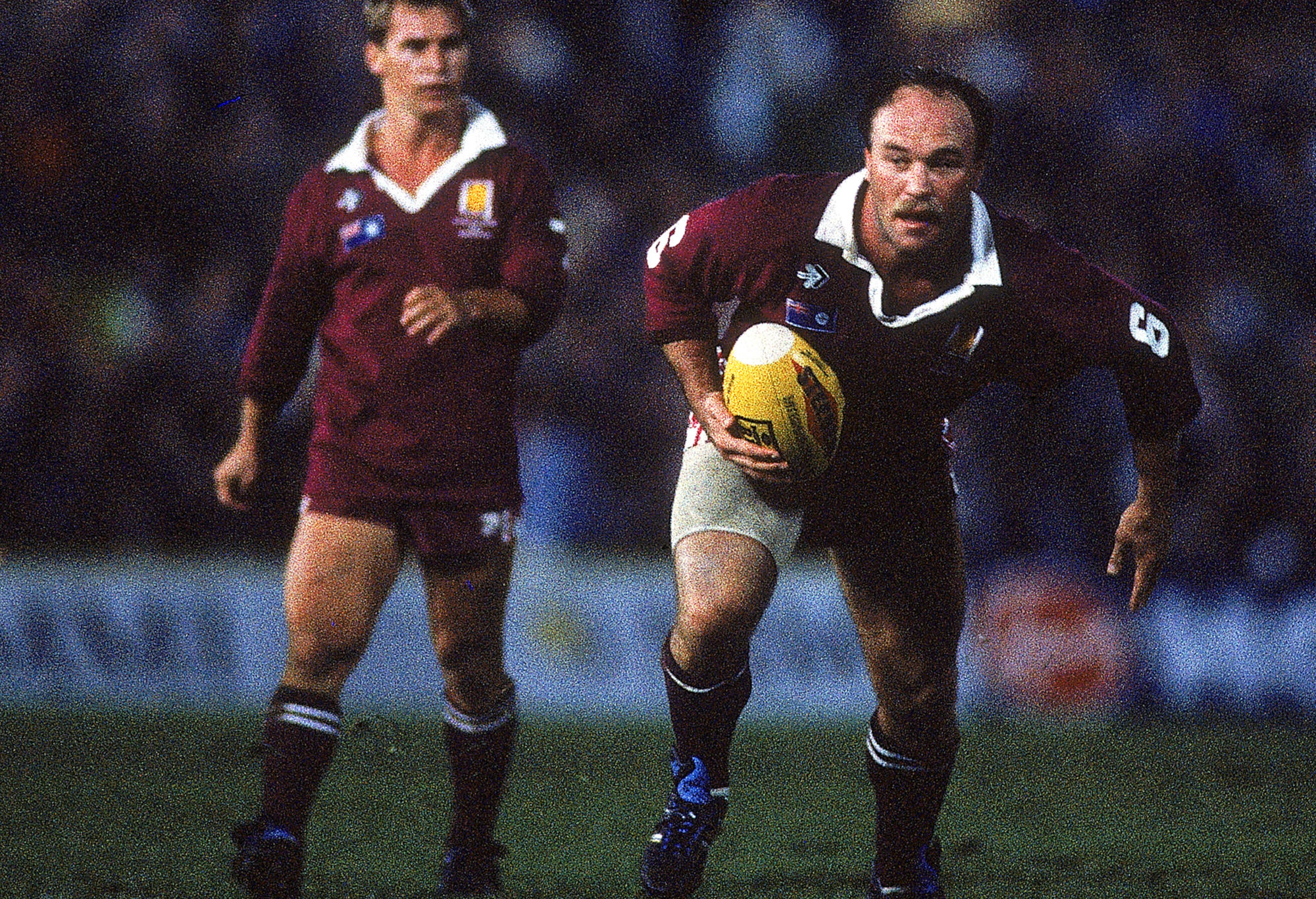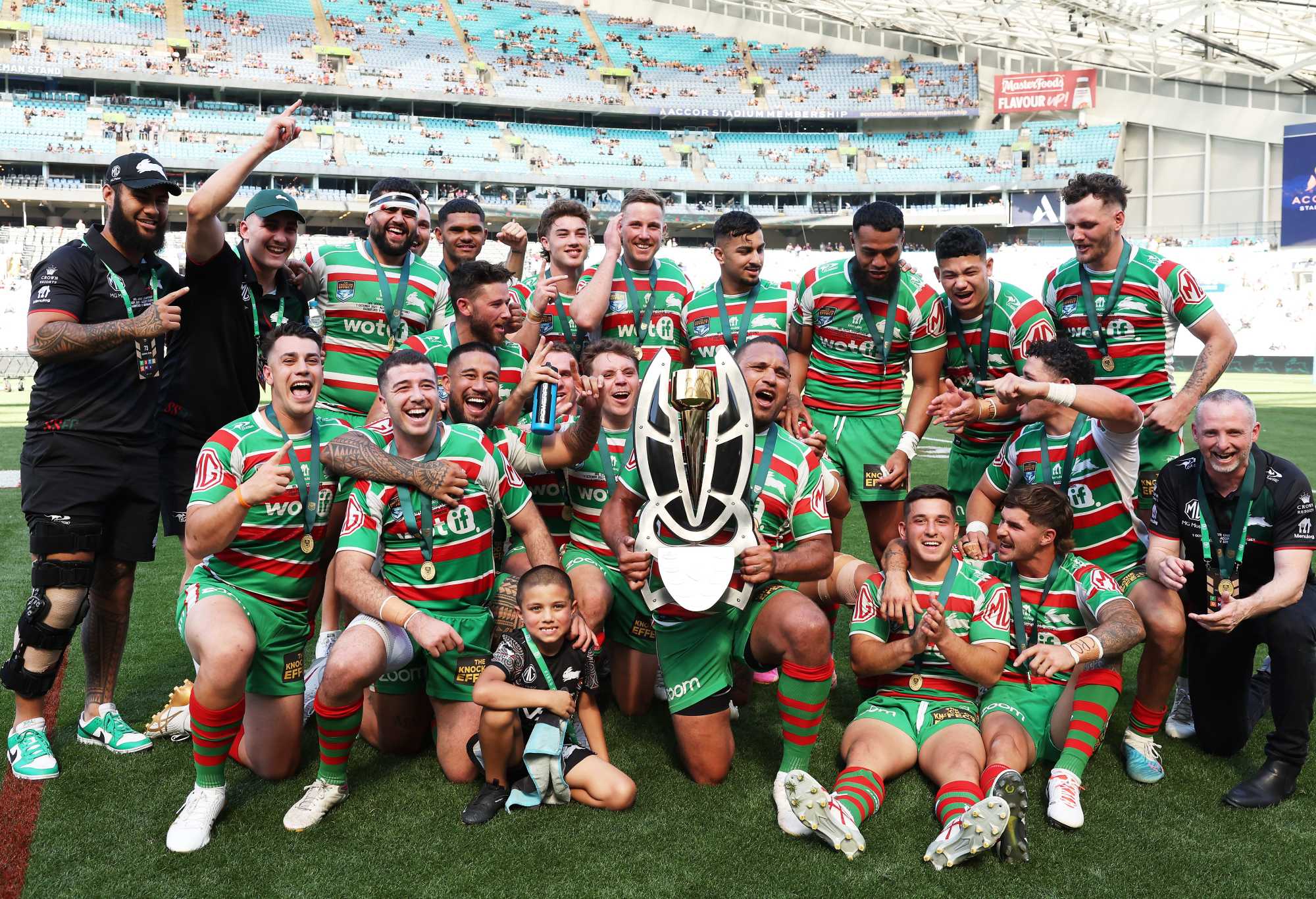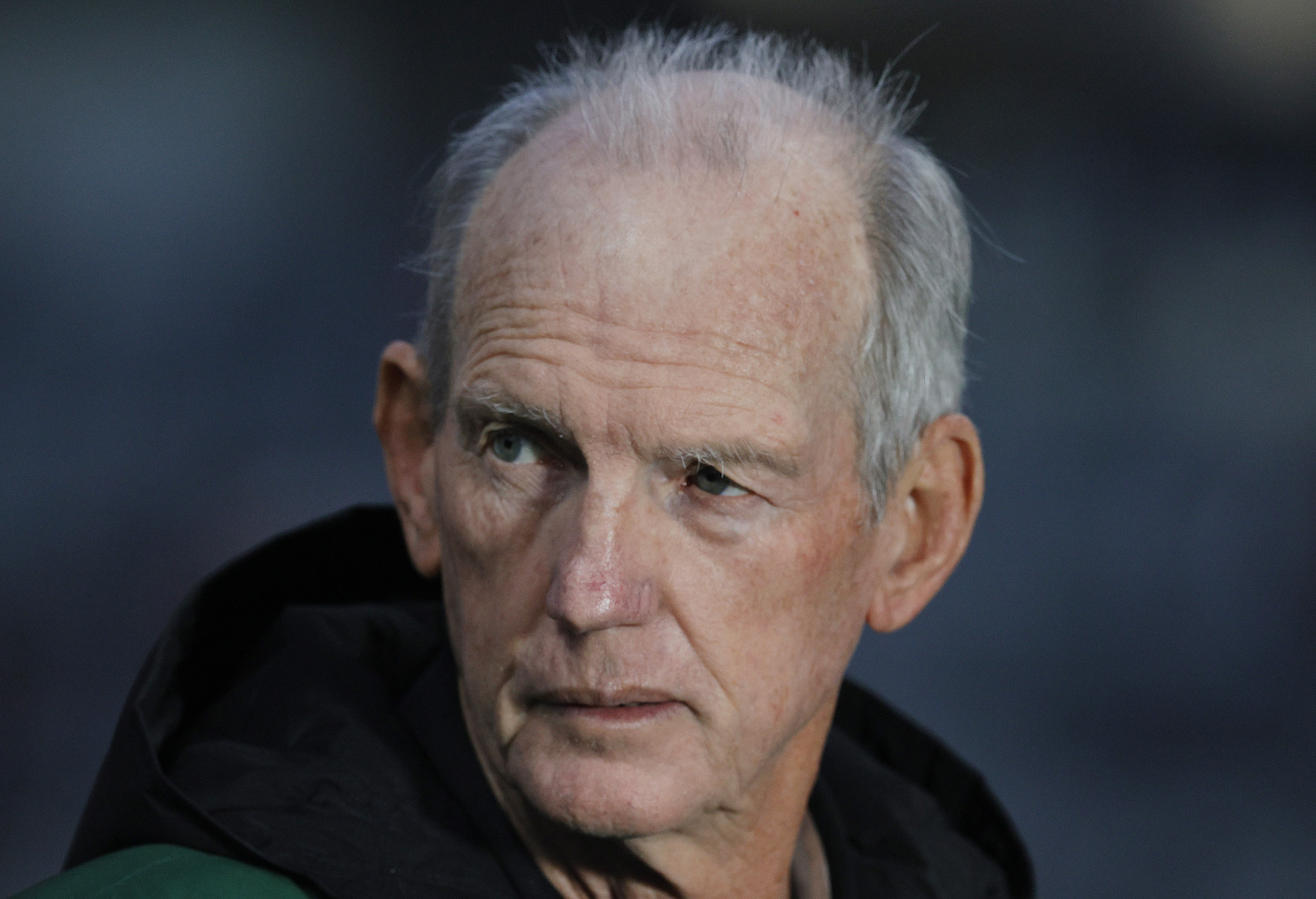On the afternoon of 30 September 1984, as the Wynnum-Manly Seagulls were busy dismantling the Souths Magpies by 42 points to 8 in the Brisbane Rugby League (BRL) Grand Final, many and varied thoughts were percolating in the minds of prominent observers.
Then South Sydney coach Ron Willey was convinced the Seagulls could beat the NSWRL Premiers Canterbury given the opportunity, while Kangaroos coach Terry Fearnley liked their hypothetical chances of reaching the pointy end of the NSWRL.
Others had more visceral reactions. Noted journalist Lawrie Kavanagh called Wynnum-Manly the greatest club team he’d ever seen. Before he left Lang Park, then Canberra coach Don Furner declared that “they’d beat a few sides in Sydney – but would be no better than a middle of the ladder team”, which is interesting given four of players on show that day, along with the losing coach, would join him in Canberra a short time later.

Wally Lewis playing for Queensland in State of Origin. (Photo by Tony Feder/Getty Images)
Of course, all this talk was part of a broader theme at the time: the future of club rugby league in Australia. With the tentacles of television expanding to all corners of the continent, multiple state club competitions were unlikely to appeal beyond, well, those states. Something had to give.
Never one to miss an opportunity, QRL Chairman Ron McAuliffe chose Wynnum’s day of triumph to float his idea for a 12-team “super league”, comprising teams from Canberra, Wollongong, Tweed Heads and north Queensland, to commence in 1988. It didn’t quite work out that way, but a lot of what McAuliffe said was remarkably prescient. Wynnum-Manly obviously has a lot to answer for.
While they never got the chance to prove their credentials against Canterbury, the Seagulls team of the mid-1980s surely belongs in any discussion about the great club teams of any era. Wally Lewis, Greg Dowling, Colin Scott, Gary Coyne, the French brothers and coach Des Morris, playing a style the rest of the BRL simply couldn’t cope with, could surely have beaten just about anybody.
They were so good that a certain Wayne Bennett, then coach of the Magpies, was briefly in danger of gaining a reputation as a serial loser.
It wasn’t until 2014, long after the Brisbane Broncos had joined the NSWRL and effectively signed the BRL’s death warrant in the process, and long after establishment of the NRL, that an interstate club championship match was added to the program.
But the concept wasn’t the NRL’s idea, or even Ron McAuliffe’s. It has roots stretching back to 1918 – possibly earlier, though it’s hard to know given the paucity of official records from the era.
The curtain-raiser to 2023’s NRL Grand Final saw Brisbane Tigers play the South Sydney reserves, with both making their first appearance in the NRL State Championship game. But it wasn’t the Rabbitohs’ first time in an interstate club championship.

The Rabbitohs celebrate victory with the NRL State Championship trophy. (Photo by Matt King/Getty Images)
South Sydney 28 vs Merthyr 10, 31 August 1918
The Sydney premiership and City Cup tended to finish a little earlier than the BRL at this time, and with the QRL often arranging an extensive program of inter-city games in addition to interstate and occasional international fixtures, somebody noticed that there was room in the calendar for a Sydney team to head north and challenge one of their Brisbane counterparts.
And so it was that “before a record attendance, numbering about 7000, at the Brisbane Cricket Ground, the Rugby League Team Championship of Australia between the leading premiership team in New South Wales (South Sydney) and the leading team in Queensland (Merthyr) was decided”.
The teams weren’t quite on an even footing, though. Souths were certainly NSWRL premiers, but Merthyr were not premiers at the time. They’d lost the 1917 final to Valleys and would lose to the Diehards again in a challenger final a few weeks after this game. They were, however, runaway BRL leaders and presumptive premiers at the time, so their participation made some sense.
For those not familiar, Merthyr were essentially the Christian Brothers rugby union club who’d decamped from the 15-man code when it shut-up-shop during the Great War. They were a forerunner to the Past Brothers Rugby League Club, but also played a formative role in the Carlton club, a forerunner to present-day Souths-Logan.
While Merthyr were minor premiers in 1918, the Rabbitohs’ convincing win might’ve thrown them off their game. They lost their next league game to Wests – an infamous affair involving one Albert ‘Rickety’ Johnston which led to Wests storming out of the competition in protest – before dropping back-to-back finals to Valleys.
And that was it – Merthyr didn’t re-appear in 1919, with some players returning to union and others joining Carlton, though they were eventually replaced by Brothers Old Boys in 1920.
As for Souths, after dealing with Merthyr they were confronted by the might of the Queensland representative team at the Gabba the following Saturday before another record attendance of 13,000. While the Rabbitohs took a commanding 19-9 lead in the second half, the Queenslanders fought back, with Nev Broadfoot’s try and JP Flynn’s late penalty salvaging a 19-all draw.
Balmain 30 vs Western Suburbs (Brisbane) 0, 7 August 1920
A couple of years later, one of the best rugby league teams of all time, featuring three future Hall of Famers, travelled north for a “meeting of champions” at the Brisbane Exhibition ground.
Again, the billing was little misleading – Wests were not BRL premiers, though they were well on their way and would win the 1920 premiership undefeated behind a powerhouse forward pack led by Kangaroos Norm Potter and Jim Bennett.

Legendary coach Wayne Bennett cut his teeth in the Brisbane Rugby League competition during the 80’s. (Photo by Mark Evans/Getty Images)
But they were no match for Balmain who’d just won their fifth Sydney premiership in six seasons, with the Brisbane Telegraph noting that “the question of supremacy was not long left in doubt. Suburbs did not play anywhere up to expectations, and against such a great combination as the visitors have, their shortcomings in almost every branch of the game were made very apparent”.
The game was the first glimpse for Queensland audiences of the great Jimmy Craig, who would go on to win three premierships with Ipswich Starlights, lead the Ipswich district team to famous victories in the inter-city cup, captain one of the great Queensland teams and be described by the Daily Standard – the organ of the labour movement and a publication not given to hyperbole – as a “genius”.
And the nascent great one didn’t disappoint, scoring a hat-trick against the BRL’s best and maybe having his head turned.
Actually, there’s a theme emerging here. Clarrie Horder who starred for Souths against Merthyr and Queensland in 1918 later moved north, as did his brother Harold who played with distinction for Coorparoo, a forerunner to the Brisbane Tigers, after touring with Norths in ‘21. What were those Queenslanders up to?
‘More interesting’ than internationals: North Sydney 24 vs Queensland 18, 2 July 1921
As far as I can gather, 1921 was the last interstate club contest for a while, possibly until some Brisbane teams entered the mid-week cup competition organised by the NSWRL in the mid-1970s. While club teams from both sides of the border occasionally crossed it, none were competing for ‘supremacy’.

Australian coach Mal Meninga was famous for his exploits as a youngster in the BRL. (Photo by Bradley Kanaris/Getty Images)
After the failures of Merthyr and Wests, a stiffer test awaited the champion North Sydney team when they headed north in 1921. It made sense too. Much like Queensland’s population and economy, the state’s rugby league talent was decentralised – the Toowoomba and Ipswich competitions were both comparable, if not stronger than the BRL at different points in the 1920s.
Toowoomba had attracted Jim Bennett from Wests and Vic Armbruster from Bangalow to go with future Kangaroo captain Tom Gorman and then Herb Steinhort, while Ipswich already had Duncan Thompson and was about to welcome certified genius Jimmy Craig.
If a BRL team had played Norths, it would probably have been Coorparoo, given eventual premiers Carlton didn’t really get their act together until after Norths had visited.
As it happened, Norths’ first test was against a Toowoomba district team at Toowoomba on 31 August, with the Mayor holding a civic reception and regretting the weather, before Norths proceeded to edge a strong Clydesdales outfit, featuring Gorman, Mick Ryan and the Melbusch brothers, 21-20.
The main course was served up at Davies Park in West End a few days later when Norths conquered the best of Queensland 24-18, with Harold Horder evidently running riot in front of the Queensland scouts.
The Telegraph noted that the game was “certainly more interesting than the exhibitions which have been given in the recent international matches”, which is perhaps confirmation that Queenslanders have either been trying to sabotage international league for over a century now, or that they think NSW is a different country. Who knows?
































































































